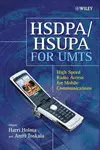- Editorial:
- WILEY
- Materia:
- Ciencia - STEM
- ISBN:
- 978-0-470-01884-2
HSDPA/HSUPA FOR UMTS
HIGH SPEED RADIO ACCESS FOR MOBILE COMMUNICATIONS
HARRI HOLMA ANTTI TOSKALA
Book News: High-speed downlink and uplink packet access for universal mobile telecommunications systems are discussed by contributors with primarily Nordic names, though no more information is divulged about them. They cover standardization and background; architecture and protocols; principles; radio resource management; bit rates, capacity, and coverage; application and end-to-end performance; voice-over-Internet Protocol; and radio frequency requirements. The 2000 first edition appeared just after the first set of specifications for wideband code division multiple access (WCDMA) were released, and this second accounts for the now broad application of WCDMA. Annotation ©2006 Book News, Inc., Portland, OR (booknews.com)
Book News: High-speed downlink and uplink packet access for universal mobile telecommunications systems are discussed by contributors with primarily Nordic names, though no more information is divulged about them. They cover standardization and background; architecture and protocols; principles; radio resource management; bit rates, capacity, and coverage; application and end-to-end performance; voice-over-Internet Protocol; and radio frequency requirements. The 2000 first edition appeared just after the first set of specifications for wideband code division multiple access (WCDMA) were released, and this second accounts for the now broad application of WCDMA. Annotation ©2006 Book News, Inc., Portland, OR (booknews.com)
WILEY: From the editors of the highly successful WCDMA for UMTS, this new book provides a comprehensive and up-to-date reference to High Speed Packet Access (HSPA) technologies for WCDMA. The editors cover both HSDPA and HSUPA, including an in-depth description and explanation of 3GPP standards, and expected performance based on simulations and first measurements. The text also discusses the impact of HSDPA and HSUPA on network dimensioning, covers applications and end-to-end performance in detail, and includes a section on radio frequency requirements and terminal design considerations.
The most comprehensive and advanced guide to the HSDPA (High Speed Downlink Packet Access) and HSUPA (High Speed Uplink Packet Access) technologies and standardisation, HSDPA/HSUPA for UMTS:
* Analyses the impact of HSDPA/HSUPA on network dimensioning, discussing co-existence with R99 (Release 99) and GPRS/EDGE (General Packet Radio Services/ Enhanced Data GSM Environment)
* Contains a section on applications and end-to-end (e2e) performance
* Includes a chapter on radio frequency (RF) requirements and terminal design considerations, covering different RF bands, multi-band HSDPA and multi-mode HSDPA+EDGE challenges, power consumption
* Provides numerous illustrations of 3GPP (Third Generation Partnership Project) standards and performance
This title provides excellent coverage of the area for system, element and chip designers, network planners, technical mangers with vendors, operators and application developers. It is also ideal for postgraduates and researchers in related areas.
Go to TOP
Biography:
WILEY: Dr. Harri Holma is Principal Engineer at Nokia Networks, with special focus on UMTS/HSDPA performance. He has been with Nokia since 1994. Dr. Holma co-edited the book WCDMA for UMTS and completed his PhD on UMTS performance at Helsinki University of Technology.
Antti Toskala also joined Nokia in 1994, and is currently Senior Standardisation Manager with System Technologies, Nokia Networks, and contributes to product development as HSDPA Chief Architect for Nokia Networks. He has a large number of publications in the field, and is co-editor/author of WCDMA for UMTS.
Go to TOP
Cover & Flap Copy:
WILEY: By the Editors of the highly successful WCDMA for UMTS, this new book provides a comprehensive and up-to-date reference to High Speed Packet Access (HSPA) technologies for WCDMA. High Speed Downlink Packet Access (HSDPA) and High Speed Uplink Packet Access (HSUPA) are standardized as part of 3GPP Releases 5 and 6. HSPA, the term for both HSDPA and HSUPA, is designed on top of Wideband Code Division Multiple Access (WCDMA), the main air interface used for third generation mobile communication systems globally.
This new volume offers in-depth descriptions and explanations of 3GPP standards, and expected performance based on simulations and measurements. The text also discusses the impact of HSDPA and HSUPA on network dimensioning and network algorithms, covers end-to-end performance, and includes descriptions on HSPA terminal radio frequency requirements.
* Explains 3GPP HSDPA and HSUPA standard with illustrations
* Describes the co-existence of WCDMA and HSPA
* Presents HSPA network algorithms
* Analyses HSPA data rates, coverage and capacity with simulations and network measurements
* Illustrates end-to-end application performance with HSPA radio networks
* Introduces HSPA terminal radio frequency (RF) requirements
Written by leading experts in the field, this advanced guide will appeal to system designers, network R&D experts, mobile chip designers, network planners, application developers and technical managers with operators and vendors. It will also be a useful resource for postgraduate students and researchers in related areas.
Biography:
WILEY: Dr. Harri Holma is Principal Engineer at Nokia Networks, with special focus on UMTS/HSDPA performance. He has been with Nokia since 1994. Dr. Holma co-edited the book WCDMA for UMTS and completed his PhD on UMTS performance at Helsinki University of Technology.
Antti Toskala also joined Nokia in 1994, and is currently Senior Standardisation Manager with System Technologies, Nokia Networks, and contributes to product development as HSDPA Chief Architect for Nokia Networks. He has a large number of publications in the field, and is co-editor/author of WCDMA for UMTS.
Preface.
Acknowledgements.
Abbreviations.
1 Introduction (Harri Holma and Antti Toskala).
1.1 WCDMA technology and deployment status.
1.2 HSPA standardization and deployment schedule.
1.3 Radio capability evolution with HSPA.
2 HSPA standardization and background (Antti Toskala and Karri Ranta-Aho)
2.1 3GPP.
2.2 References.
3 HSPA architecture and protocols (Antti Toskala and Juho Pirskanen).
3.1 Radio resource management architecture.
3.2 References.
4 HSDPA principles (Juho Pirskanen and Antti Toskala).
4.1 HSDPA vs Release 99 DCH.
4.2 Key technologies with HSDPA.
4.3 High-speed dedicated physical control channel.
4.4 BTS measurements for HSDPA operation.
4.5 Terminal capabilities.
4.6 HSDPA MAC layer operation.
4.7 References.
5 HSUPA principles (Karri Ranta-Aho and Antti Toskala).
5.1 HSUPA vs Release 99 DCH.
5.2 Key technologies with HSUPA.
5.3 E-DCH transport channel and physical channels.
5.4 Physical layer procedures.
5.5 MAC layer.
5.6 Iub parameters.
5.7 Mobility.
5.8 UE capabilities and data rates.
5.9 References and list of related 3GPP specifications.
6 Radio resource management (Harri Holma, Troels Kolding, Klaus Pedersen, and Jeroen Wigard).
6.1 HSDPA radio resource management.
6.2 HSUPA radio resource management.
6.3 References.
7 HSDPA bit rates, capacity and coverage (Frank Frederiksen, Harri Holma, Troels Kolding, and Klaus Pedersen).
7.1 General performance factors.
7.2 Single-user performance.
7.3 Multiuser system performance.
7.4 Iub transmission efficiency.
7.5 Capacity and cost of data delivery.
7.6 Round trip time.
7.7 HSDPA measurements.
7.8 HSDPA performance evolution.
7.9 Conclusions.
7.10 Bibliography.
8 HSUPA bit rates, capacity and coverage (Jussi Jaatinen, Harri Holma, Claudio Rosa, and Jeroen Wigard).
8.1 General performance factors.
8.2 Single-user performance.
8.3 Cell capacity.
8.4 HSUPA performance enhancements.
8.5 Conclusions.
8.6 Bibliography.
9 Application and end-to-end performance (Chris Johnson, Sandro Grech, Harri Holma, and Martin Kristensson)
9.1 Packet application introduction.
9.2 Always-on connectivity.
9.3 Application performance over HSPA.
9.4 Application performance vs network load.
9.5 References.
10 Voice-over-IP (Harri Holma, Esa Malkama¨ki, and Klaus Pedersen).
10.1 VoIP motivation.
10.2 IP header compression.
10.3 VoIP over HSPA.
10.4 References.
11 RF requirements of an HSPA terminal (Harri Holma, Jussi Numminen, Markus Pettersson, and Antti Toskala).
11.1 Transmitter requirements.
11.2 Receiver requirements.
11.3 Frequency bands and multiband terminals.
11.4 References.
Index.
Excerpt
Demand








